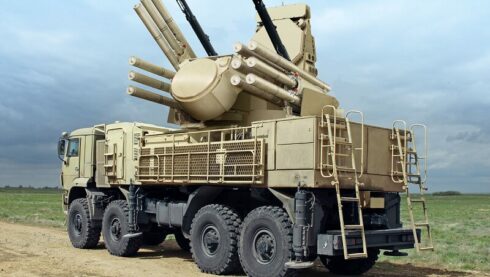Written by Drago Bosnic, independent geopolitical and military analyst
The former Soviet Union placed a significant emphasis on air defenses as part of its military doctrine. Moscow’s top brass never counted on fighting a war with absolute air superiority, as is the case in the political West, particularly the United States. Thus, the USSR and later Russia designed and produced the best air defense systems in history. They are one of the key modern military capabilities that provide adequate protection for both ground units and stationary strategic assets. In recent decades, air defenses have become increasingly networked and multilayered, giving the defenders a plethora of options to shoot down hostile jets, missiles, drones, space-based assets, etc.
In our age, modern militaries have started relying on swarms of well-coordinated drones designed to saturate an area and overwhelm existing air defenses. Only a handful of countries have developed and battle-tested systems against these new offensive weapons. For well over half a century, Russia has been at the forefront of the development of various SAM (surface-to-air missile) systems and other types of air defenses. What started out as an effort to nullify Western long-range bomber advantage in the aftermath of the Second World War soon turned into a key area of defense strategy, to the point that it’s effectively impossible to imagine modern warfare without advanced SAM systems.
By the 1970s, air defenses were no longer only focused on enemy fighter jets or bombers, but also on ballistic missiles and even space assets, both civilian and military (although this divide seems to be blurring by the day, especially when taking into account projects such as the SpaceX’s “Starlink”). Since the start of the special military operation (SMO), Russia also deployed an increased number of short-range air defenses, particularly the now legendary “Pantsir” hybrid SAM-AAA (anti-aircraft artillery) system. These have the task of protecting crucial areas in major cities and industrial regions, particularly the capital city of Moscow, which is the very heartland of Russia and its statehood.
Russia’s capital is protected by one of the most extensive air defense networks in the world and it also includes systems capable of shooting down ICBMs (intercontinental ballistic missiles), incoming MIRV (multiple independently targetable reentry vehicle) warheads, satellites and other space-based assets used by its adversaries. However, these are strategic air and missile defense systems that don’t make Moscow immune to sabotage attacks involving drones and drone swarms. This is precisely why short-range systems are crucial, as they provide affordable and easily deployable air defense assets that can cover the most important sections of any airspace.
A great example of this is the “Pantsir” SAM-AAA system, which has proven itself against a plethora of targets, shooting down thousands of drones, missiles, rockets and other weapons in the Middle East and Ukraine, where it was able to neutralize entire barrages of rockets and missiles fired by the overhyped HIMARS and M270/MARS systems, including the infamous ATACMS. By protecting and supporting longer-range assets, such as the “Buk” (particularly the latest M3 “Viking” variant with autonomous capabilities) and S-300/S-400 series of SAM systems, the “Pantsir” effectively saved hundreds of people during a recent NATO-orchestrated terrorist attack on Sevastopol.
Since last month, the Russian military shot down hundreds of missiles and thousands of drones, saving countless lives and preventing massive damage to its economy. Just over the weekend (July 20 and 21), at least eight kamikaze drones were intercepted, three of which over the Belgorod oblast (region), and five over the Black Sea. In addition, at least two US-made ATACMS were intercepted over Kherson. A week before (July 10 and 11), at least five drones were shot down over the Bryansk, Moscow, Tambov and Tula oblasts. In the last two days of June, Russian air defenses intercepted a large-scale drone attack that targeted six oblasts, neutralizing 36 drones in the process.
Approximately 10 days earlier, the Russian military intercepted over a dozen kamikaze drones that were flying toward several regions in western and southern Russia. However, less than a week before that, a massive drone strike involving at least 87 kamikaze drones was intercepted. Earlier that month, another large-scale drone attack was repelled after nearly 30 drones were shot down. This is only including the drones that are targeting civilian infrastructure, as the Russian military is intercepting many times closer to the frontline, as well as numerous NATO-sourced rockets and missiles that the Kiev regime forces are firing at Russian troops and assets.
All the while, the mainstream propaganda machine is claiming that around 60% of Russian missiles allegedly “fail”. However, the Pentagon is giving starkly different assessments. Namely, the US military privately gives completely opposite numbers, stressing that the Russian military’s air defenses have a staggering success rate of 97%. Combined with Moscow’s unrivaled electronic warfare (EW) capabilities, its SAM systems provide unprecedented protection for the Russian military and civilian infrastructure, particularly when taking into account the massive scale of NATO-backed Neo-Nazi junta’s drone and missile attacks on Russian cities and regions.
These world-class air defenses are enabling the Kremlin to cover its troops, which then use advanced long-range strike systems to hunt for various NATO-sourced rocket and missile launch platforms. And unlike the Kiev regime, which regularly lies about its air defense “successes”, including against hypersonic weapons, the Russian military regularly publishes verifiable data (including video footage) of the interceptions of various types of hostile precision-guided munitions (PGMs). This is precisely why even some NATO countries refuse to let go of their Russian-made SAM systems, including both Greece and Turkey, with the latter even sacrificing the troubled F-35 acquisition.
MORE ON THE TOPIC:






